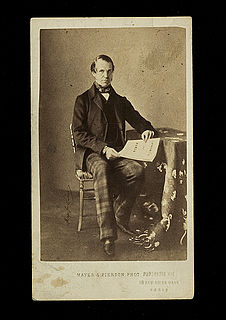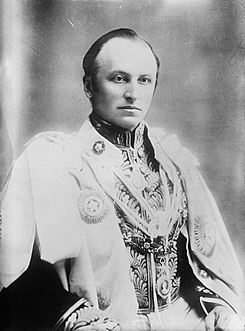
Marquess of Abergavenny in the County of Monmouth, is a title in the Peerage of the United Kingdom that was created on 14 January 1876, along with the title Earl of Lewes, in the County of Sussex, for the 5th Earl of Abergavenny, a member of the Nevill family.

Earl of Iddesleigh, in the County of Devon, is a title in the Peerage of the United Kingdom. It was created in 1885 for the Conservative politician Sir Stafford Northcote, 8th Baronet, of Pynes in the parish of Upton Pyne near Exeter in Devon and lord of the manor of Iddesleigh, 28 miles north-west of Pynes. He served as President of the Board of Trade, Secretary of State for India, Chancellor of the Exchequer, First Lord of the Treasury and Foreign Secretary and was Joint Leader of the Conservative Party from 1881 to 1885. Northcote was made Viscount St Cyres, of Newton Saint Cyres in the County of Devon, at the same time he was given the earldom. This title is also in the Peerage of the United Kingdom.

Earl Cowley is a title in the Peerage of the United Kingdom. It was created in 1857 for the diplomat Henry Wellesley, 2nd Baron Cowley. He was Ambassador to France from 1852 to 1867. He was made Viscount Dangan, of Dangan in the County of Meath, at the same time as he was given the earldom. This title is also in the Peerage of the United Kingdom. Lord Cowley was the eldest son of Henry Wellesley, 1st Baron Cowley, who like his son served as Ambassador to France. In 1828 he was created Baron Cowley, of Wellesley in the County of Somerset, in the Peerage of the United Kingdom. A member of the prominent Wellesley family, Cowley was the fifth and youngest son of Garret Wellesley, 1st Earl of Mornington, and the younger brother of Arthur Wellesley, 1st Duke of Wellington, and Richard Wellesley, 1st Marquess Wellesley.
Viscount Leathers, of Purfleet in the County of Essex, is a title in the Peerage of the United Kingdom. It was created on 18 January 1954 for the businessman, Conservative politician and public servant Frederick Leathers, 1st Baron Leathers. He had already been created Baron Leathers, of Purfleet in the County of Essex, on 19 May 1941, also in the Peerage of the United Kingdom. As of 2020 the titles are held by his grandson, the third Viscount, who succeeded his father in 1996.

Baron Hacking, of Chorley in the County Palatine of Lancaster, is a title in the Peerage of the United Kingdom. It was created in 1945 for the Conservative politician Sir Douglas Hacking, 1st Baronet. He was Chairman of the Conservative Party from 1936 to 1942. Hacking had already been created a baronet in 1938. As of 2011 the titles are held by his grandson, the third Baron, who succeeded his father in 1971.
Baron Davies, of Llandinam in the County of Montgomery, is a title in the Peerage of the United Kingdom. It was created in 1932 for the Welsh businessman, Liberal Member of Parliament and philanthropist, David Davies. He was the grandson and namesake of the prominent industrialist David Davies Llandinam.

Baron Wrenbury, of Old Castle, Dallington in the County of Sussex, is a title in the Peerage of the United Kingdom. It was created in 1915 for the barrister and judge Sir Henry Buckley. He served as a Judge of the High Court of Justice and as a Lord Justice of Appeal. As of 2014 the title is held by his great-grandson, the fourth Baron, who succeeded his father in 2014. The Hon. Sir Denys Buckley, younger son of the first Baron, was also a Judge of the High Court of Justice and Lord Justice of Appeal.

Baron Merthyr, of Senghenydd in the County of Glamorgan, is a title in the Peerage of the United Kingdom. It was created in 1911 for the Welsh coal mining magnate Sir William Lewis, 1st Baronet. He had already been created a baronet, of Nantgwyne in the County of Glamorgan, in 1896. The barony is named after the town of Merthyr Tydfil, where Lewis was born. Lord Merthyr's grandson, the third Baron, was Chairman of Committees in the House of Lords from 1957 to 1965 and a Deputy Speaker from 1957 to 1974. The latter was succeeded by his son, the fourth Baron. He disclaimed the peerage for life on 26 April 1977, three weeks after succeeding his father. He did not use his title of baronet either. He died on 5 August 2015.
Baron Mottistone, of Mottistone in the County of Southampton, is a title in the Peerage of the United Kingdom. It was created in 1933 for the soldier and Liberal politician J. E. B. Seely. He was the fourth son of Sir Charles Seely, 1st Baronet, and the uncle of The 1st Baron Sherwood. The 4th Baron Mottistone succeeded his half-brother in 1966. He notably served Lord Lieutenant of the Isle of Wight from 1986 to 1995 and as the last governor of the Isle of Wight between 1992 and 1995 and was succeeded by his son as the fifth baron, in 2011. In turn, the fifth baron was succeeded by his elder son in 2013.

Baron Baillieu, of Sefton in the Commonwealth of Australia and of Parkwood in the County of Surrey, is a title in the Peerage of the United Kingdom. It was created in 1953 for the businessman and public servant, Sir Clive Baillieu, the son of the Australian financier and politician William Baillieu. Baillieu was Chairman and President of the Dunlop Rubber Company and President of the Federation of British Industries and also worked for the British government during the Second World War. As of 2010 the title is held by his grandson, the third Baron, who succeeded his father in 1973.
Baron Bridges, of Headley in the County of Surrey and of Saint Nicholas at Wade in the County of Kent, is a title in the Peerage of the United Kingdom. It was created on 4 February 1957 for the prominent civil servant Sir Edward Bridges. He was Cabinet Secretary from 1938 to 1946. He was succeeded by his son, the second Baron, in 1969. He notably served as British Ambassador to Italy from 1983 to 1987. Lord Bridges was one of the ninety-two elected hereditary peers that remained in the House of Lords after the passing of the House of Lords Act 1999, before his removal for non-attendance in 2016. As of 2017 the title is held by his son, the third Baron, who succeeded to the title in that year. He is the solicitor to, among others, Queen Elizabeth II of the United Kingdom and other members of the Royal family. The first Baron was the son of poet laureate Robert Bridges. The first Baron's grandson and current Baron's cousin was created a Life Peer as Baron Bridges of Headley.
Baron Chorley, of Kendal in the County of Westmorland, is a title in the Peerage of the United Kingdom. It was created on 16 November 1945 for the barrister, academic and Labour politician, Robert Chorley. He was Sir Ernest Cassel Professor of Commercial and Industrial Law at the University of London from 1930 to 1946 and served as a Lord-in-waiting from 1946 to 1950 in the Labour administration of Clement Attlee. The second Baron, who succeeded his father in 1978, was one of the ninety elected hereditary peers elected remain in the House of Lords after the passing of the House of Lords Act of 1999, where he sat as a cross-bencher. As of 2016 the title is held by his son.
Baron Clydesmuir, of Braidwood in the County of Lanark, Scotland, is a title in the Peerage of the United Kingdom. It was created in 1948 for the Unionist politician John Colville. He served as Secretary of State for Scotland from 1938 to 1940. His son, the second Baron, was Governor of the Bank of Scotland and Lord Lieutenant of Lanarkshire. As of 2010 the title is held by the latter's son, the third Baron, who succeeded in 1996.

Baron Rothschild, of Tring in the County of Hertfordshire, is a title in the Peerage of the United Kingdom. It was created in 1885 for Sir Nathan Rothschild, 2nd Baronet, a member of the Rothschild banking family. He was the first Jewish member of the House of Lords not to have previously converted to Christianity. The current holder of the title is Jacob Rothschild, 4th Baron Rothschild, who inherited the title in 1990.
Baron Revelstoke, of Membland in the County of Devon, is a title in the Peerage of the United Kingdom. It was created on 30 June 1885 for the businessman Edward Baring, head of the family firm of Barings Bank and a member of the Baring family. Baring was the son of Henry Baring, third son of Sir Francis Baring, 1st Baronet, and the nephew of Alexander Baring, 1st Baron Ashburton, the second cousin of Francis Baring, 1st Baron Northbrook, the elder brother of Evelyn Baring, 1st Earl of Cromer and the uncle of Evelyn Baring, 1st Baron Howick of Glendale. He was succeeded by his second but eldest surviving son John, the second Baron. John was a partner in Baring Brothers and Co. Ltd, a Director of the Bank of England, and also served as Lord Lieutenant of Middlesex. On his death the title passed to his younger brother Cecil, the third Baron. He acquired Lambay Island, north of Dublin, in 1904. As of 2017 the title is held by his great-grandson, the seventh Baron, who succeeded his father in 2012.

Baron Ravensdale, of Ravensdale in the County of Derby, is a title in the Peerage of the United Kingdom.
The Astor family achieved prominence in business, society, and politics in the United States and the United Kingdom during the 19th and 20th centuries. With ancestral roots in the Italian Alps, the Astors settled in Germany, first appearing in North America in the 18th century with John Jacob Astor, one of the wealthiest people in history.
John Percival Davies, 1st Baron Darwen, was a British cotton manufacturer and Labour politician.
 John Percival Davies, 1st Baron Darwen (1885–1950)[ citation needed ]
John Percival Davies, 1st Baron Darwen (1885–1950)[ citation needed ]






